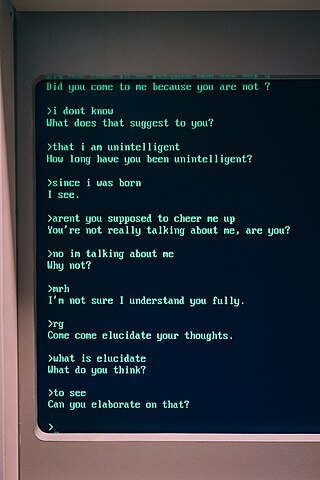Top Qs
Timeline
Chat
Perspective
ELIZA effect
Cognitive bias in which computers are anthropomorphised From Wikipedia, the free encyclopedia
Remove ads
In computer science, the ELIZA effect is a tendency to project human traits — such as experience, semantic comprehension or empathy — onto rudimentary computer programs having a textual interface. ELIZA was a symbolic AI chatbot developed in 1966 by Joseph Weizenbaum that imitated a psychotherapist. Many early users were convinced of ELIZA's intelligence and understanding, despite its basic text-processing approach and the explanations of its limitations.

Remove ads
History
Summarize
Perspective
The effect is named for ELIZA, the 1966 chatbot developed by MIT computer scientist Joseph Weizenbaum. When executing Weizenbaum's DOCTOR script, ELIZA simulated a Rogerian psychotherapist, largely by rephrasing the "patient"'s replies as questions:[1]
- Human: Well, my boyfriend made me come here.
- ELIZA: Your boyfriend made you come here?
- Human: He says I'm depressed much of the time.
- ELIZA: I am sorry to hear you are depressed.
- Human: It's true. I'm unhappy.
- ELIZA: Do you think coming here will help you not to be unhappy?
Though designed strictly as a mechanism to support "natural language conversation" with a computer,[2] ELIZA's DOCTOR script was found to be surprisingly successful in eliciting emotional responses from users who, in the course of interacting with the program, began to ascribe understanding and motivation to the program's output.[3] As Weizenbaum later wrote, "I had not realized ... that extremely short exposures to a relatively simple computer program could induce powerful delusional thinking in quite normal people."[4] Indeed, ELIZA's code had not been designed to evoke this reaction in the first place. Upon observation, researchers discovered users unconsciously assuming ELIZA's questions implied interest and emotional involvement in the topics discussed, even when they consciously knew that ELIZA did not simulate emotion.[5]
Although the effect was first named in the 1960s, the tendency to understand mechanical operations in psychological terms was noted by Charles Babbage. In proposing what would later be called a carry-lookahead adder, Babbage remarked that he found such terms convenient for descriptive purposes, even though nothing more than mechanical action was meant.[6]
Remove ads
Characteristics
Summarize
Perspective
In its specific form, the ELIZA effect refers only to "the susceptibility of people to read far more understanding than is warranted into strings of symbols—especially words—strung together by computers".[7] A trivial example of the specific form of the Eliza effect, given by Douglas Hofstadter, involves an automated teller machine which displays the words "THANK YOU" at the end of a transaction. A naive observer might think that the machine is actually expressing gratitude; however, the machine is only printing a preprogrammed string of symbols.[7]
More generally, the ELIZA effect describes any situation[8][9] where, based solely on a system's output, users perceive computer systems as having "intrinsic qualities and abilities which the software controlling the (output) cannot possibly achieve"[10] or "assume that [outputs] reflect a greater causality than they actually do".[11] In both its specific and general forms, the ELIZA effect is notable for occurring even when users of the system are aware of the determinate nature of output produced by the system.
From a psychological standpoint, the ELIZA effect is the result of a subtle cognitive dissonance between the user's awareness of programming limitations and their behavior towards the output of the program.[12]
Remove ads
Significance
Summarize
Perspective
The discovery of the ELIZA effect was an important development in artificial intelligence, demonstrating the principle of using social engineering rather than explicit programming to pass a Turing test.[13]
ELIZA convinced some users into thinking that a machine was human. This shift in human-machine interaction marked progress in technologies emulating human behavior. Two groups of chatbots are distinguished by William Meisel as "general personal assistants" and "specialized digital assistants".[14] General digital assistants have been integrated into personal devices, with skills like sending messages, taking notes, checking calendars, and setting appointments. Specialized digital assistants "operate in very specific domains or help with very specific tasks".[14] Weizenbaum considered that not every part of the human thought could be reduced to logical formalisms and that "there are some acts of thought that ought to be attempted only by humans".[15]
When chatbots are anthropomorphized, they tend to portray gendered features as a way through which we establish relationships with the technology. "Gender stereotypes are instrumentalised to manage our relationship with chatbots" when human behavior is programmed into machines.[16] Feminized labor, or women's work, automated by anthropomorphic digital assistants reinforces an "assumption that women possess a natural affinity for service work and emotional labour".[17] In defining our proximity to digital assistants through their human attributes, chatbots become gendered entities.
See also
References
Further reading
Wikiwand - on
Seamless Wikipedia browsing. On steroids.
Remove ads
